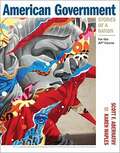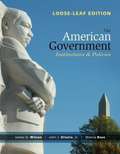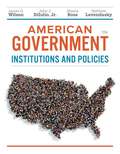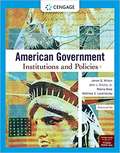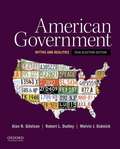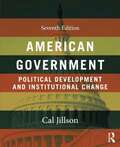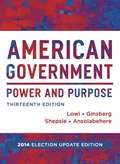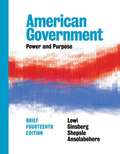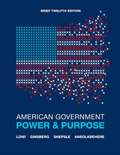- Table View
- List View
American Government: Brief Version (8th edition)
by James Q. WilsonThe president gets elected because of some slick television ads, although he has ducked all the tough questions. His party's platform is a meaningless set of words that gives you no idea what he will do in office. Once in the White House. He proposes bill and then Congress decides which to pass.
American Government: Citizenship and Power
by Christine Barbour Gerald C. WrightNIMAC-sourced textbook
American Government: Continuity and Change (2002 edition)
by Karen O'Connor Larry J. SabatoThis new edition of the number one book in American government continues to provide the most current and engaging introduction available for the course. Written with the belief that knowledge of the development of American government is integral to fully understand our current political system, "American Government: Continuity and Change" offers a strong historical perspective that highlights the evolution of government and engages students with examples relevant to their lives.
American Government: Continuity and Change (2008 Edition)
by Karen O'Connor Larry J. SabatoGuided by the belief that students must first understand how American government developed to fully understand the issues facing the United States in the 21st century, the authors offer the strongest coverage of both history and current events of any college textbook devoted to American politics. This best-selling book provides the historical context students need to understand our government and the most crucial and controversial issues affecting the nation. American Government: Continuity and Change, has been extensively revised to provide the most in-depth and current coverage of the 2006 midterm elections, the second George W. Bush administration, the Iraq War, and increasing controversies related to the conduct of the war on terrorism, including renewed calls for additional congressional oversight of the Executive Branch. The new edition also emphasizes the extent to which shared American values shape and affect policy and influence key political conflicts.
American Government: Freedom, Rights, Responsibilities
by Vivian BernsteinAmerican Government tells the story of how our government came to be. You will learn about all the branches of the government and their many jobs and see how leaders are elected, and how people can make a difference. You will learn about the role our government plays as one nation among many, and see that your government is "of the people, by the people, for the people." The book has two important pieces of writing-the Declaration of Independence and the Constitution of the United States.
American Government: Historical, Popular, and Global Perspectives (Brief Edition)
by Kenneth Dautrich David YalofGenerating thoughtful discussion can be a challenge with today's sometimes politically indifferent students. The authors of AMERICAN GOVERNMENT: HISTORICAL, POPULAR, & GLOBAL PERSPECTIVES tackle this issue with a streamlined and visually appealing version of their more comprehensive text that helps you create a lively, engaging classroom. Well-organized and easy to understand, this brief edition is a handy, less expensive paperback your students will refer to long after completing your course.
American Government: Institutions & Policies, AP* Edition
by James Q. Wilson John J. Diiulio Meena BoseNIMAC-sourced textbook
American Government: Institutions & Policies, AP* Edition
by James Q. Wilson Meena Bose John J. Dilulio Jr.NIMAC-sourced textbook
American Government: Institutions & Policies, AP® Edition
by James Q. Wilson John J. Diiulio Meena BoseNIMAC-sourced textbook
American Government: Institutions And Policies
by James Q. Wilson John J. Diiulio Meena BoseAcclaimed for the scholarship of its prominent authors and the clarity of its narrative, AMERICAN GOVERNMENT: INSTITUTIONS AND POLICIES sets the standard for public policy coverage while maintaining focus on three fundamental topics: the institutions of American government; the historical development of governmental procedures, actors, and policies; and who governs in the United States and to what ends. Reader involvement in the material is bolstered by features such as learning objectives, Constitutional Connections relating current issues to founding principles, and How Things Work boxes that illustrate important concepts. Available separately, a state-of-the-art media package with online tools makes the learning experience engaging and accessible.
American Government: Institutions And Policies
by James Q. Wilson John J. Dilulio Meena BoseThorough yet concise, this popular brief book emphasizes the historical development of the American political system, who governs, and to what ends. The twelfth edition of AMERICAN GOVERNMENT: INSTITUTIONS AND POLICIES, BRIEF VERSION, offers coverage of the 2014 campaigns and elections; budget battles and the sequestration of funds; ongoing debates about immigration, gay marriage, and other key issues in American politics; and foreign-policy decisions on Afghanistan, the Middle East, and North Korea.
American Government: Institutions And Policies
by James Q. Wilson Meena Bose John J. DiIulio Jr.NIMAC-sourced textbook
American Government: Institutions and Policies
by Matthew Levendusky Meena Bose James Wilson John DiIulioAMERICAN GOVERNMENT: INSTITUTIONS AND POLICIES is a clear and approachable text for students trying to successfully understand American government. It sets the standard for examining current issues in American politics, focusing on the importance of American governmental institutions, the historical development of governmental procedures and policies as well as on who governs in the United States and to what ends. The sixteenth edition includes concise learning objectives, highlighted key concepts and opportunities for practical application of contemporary debates on policy dynamics. These features allow students to identify important issues in American politics, maximize comprehension and engage with the material in a meaningful way.
American Government: Institutions and Policies (10th ed.)
by James Q. Wilson John J. Diiulio Jr.The guide includes chapter focus, study outlines, "Did You Think That...?" and practice questions with answers.
American Government: Institutions and Policies (8th, Post-9/11 Edition)
by James Q. Wilson John J. DilulioIn preparing this edition, the authors have taken a look at how the book has grown in recent years and have tried to cut its length judiciously, without sacrificing any important content. They have also been alert to some major issues that have come to influence politics, analyzing some extensively and minimizing a few that, in retrospect, seem less important.
American Government: Institutions and Policies (MindTap Course List)
by James Q. Wilson Jr. Meena Bose Matthew S. Levendusky John J. DiIulioCombining practical insight and examples with MindTap's anywhere, anytime digital learning tools, Wilson/Dilulio/Bose/Levendusky's AMERICAN GOVERNMENT: INSTITUTIONS AND POLICIES, ENHANCED, 16th Edition, equips you with a thorough understanding of the U.S. government. <p><p> It examines current issues in American politics, focusing on the importance of governmental institutions, the historical development of governmental procedures and policies as well as on who governs in the U.S. and to what ends. Up-to-date coverage includes changes during the Trump administration and results of the 2018 midterm elections. Clear learning objectives and highlighted key concepts help you know exactly what to focus on, while links to contemporary debates on policy dynamics enable you to identify important issues in American politics, apply what you learn and maximize course success.
American Government: Institutions and Policies, AP® Edition
by James Q. Wilson John J. Diiulio Jr. Matthew Levendusky Meena BoseNIMAC-sourced textbook
American Government: Myths And Realities
by Robert Dudley Alan Gitelson Melvin DubnickWe just experienced a historic election--driven more by common political myths and less by its realities--that will impact our political and personal lives for years to come. Rather than dismissing those myths as outright falsehoods, American Government: Myths and Realities, 2016 Election Edition, encourages students to confront their preconceived notions in order to think critically about government and politics. Clearly and distinctively woven into each chapter, the myths-and-realities theme provides a pedagogical framework that engages students with interesting questions while effectively covering the core concepts of American government. Priced at only $79.95, this affordable best seller provides students with definitive coverage of American government while laying out the foundation for today's generation to have a more sophisticated appreciation for our complex, yet exciting, system of governance.
American Government: Political Development and Institutional Change
by Cal JillsonHistory matters. America’s past is present in all aspects of the contemporary political system. Cal Jillson uses political development and the dynamics of change as a tool to help students understand how politics works now―and how institutions, participation, and policies have evolved over time to produce this political environment. Going one step further, Jillson helps students think critically about how American democracy might evolve further, focusing in every chapter on reform and further change.
American Government: Power And Purpose
by Benjamin Ginsberg Stephen Ansolabehere Theodore J. Lowi Kenneth A. ShepsleThe text that professors trust to get students thinking analytically about American government now includes new content on how race, gender, and group identity intersect with political behavior and institutions. And, leading scholars have contributed new "Analyzing the Evidence" features that engage students with the questions and methods that political students use themselves. The 2014 Election Update editions include results and analysis from the 2014 election results as well as updated discussions of other important political developments, such as Obama's executive orders on immigration and the new limits on the filibuster. In addition, many figures and tables have been updated with the latest data.
American Government: Power And Purpose
by Benjamin Ginsberg Stephen Ansolabehere Theodore Lowi Kenneth ShepsleThe brief text that gets students thinking analytically. <p><p> Based on the Full Edition of American Government: Power and Purpose, but with a simpler framework, the Fourteenth Brief Edition combines authoritative, concise coverage of the central topics in American politics with smart pedagogical features designed to get students thinking analytically. The Fourteenth Edition has been thoroughly updated through the 2016 elections, and now brings an analytical perspective to current policy issues in new "Policy Principle" sections.
American Government: Power and Purpose
by Benjamin Ginsberg Stephen Ansolabehere Theodore J. Lowi Kenneth A. ShepsleThoroughly updated based on recent scholarship and current events, American Government: Power and Purpose remains the gold standard for teaching a political scientific perspective on American government. Thorough analysis of the 2018 midterm elections and the first years of the Trump presidency make this revision more current and authoritative than ever.
American Government: Power and Purpose (Brief 12th Edition)
by Benjamin Ginsberg Stephen Ansolabehere Theodore J. Lowi Kenneth A. ShepsleBased on the Full Edition of American Government: Power and Purpose but with a simpler framework, the Brief Edition combines authoritative, concise coverage of the central topics in American politics with smart pedagogical features designed to get students thinking analytically. The Twelfth Edition has been extensively revised by new co-author Stephen Ansolabehere and updated with new pedagogy.
American Government: Power and Purpose (Thirteenth Edition)
by Benjamin Ginsberg Stephen Ansolabehere Theodore J. Lowi Kenneth A. ShepsleThe text that professors trust to get students thinking analytically about American government now includes new content on how race, gender, and group identity intersect with political behavior and institutions. And, leading scholars have contributed new "Analyzing the Evidence" features that engage students with the questions and methods that political students use themselves.


